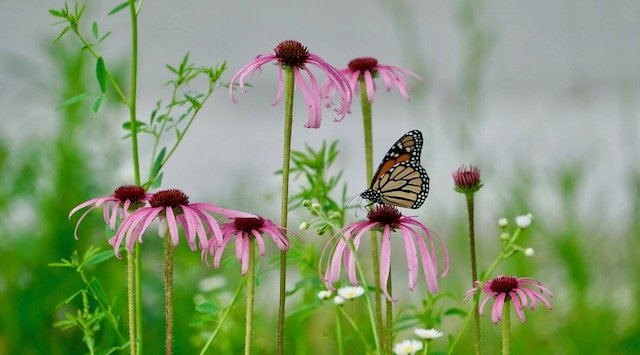Field notes by Jeff Cantrell, nature photography by Becky Wylie
They may have the stamina of an endurance athlete, the appetite of a teenager, and possess antics of a trapeze artist. Lastly, the little charmers may hold our attention like a Branson entertainer…they are our resident hummingbirds.
The month of May is gardening time and it is common for hummingbird admirers to supplement a liquid feeder with a few annuals planted around the patio. I recommend we stick with heirloom forbs to insure they are not hybrid plants lacking sweet nectar and the “wild” traits a hummer desires. Judging from my personal landscaping, I suggest heirloom Mexican sunflowers, scarlet runner beans, salvias, and an heirloom fuchsia nestled in a hanging basket. I have a variety of choice native flowers including the early blooming ones previously mentioned and specifically the yellow honeysuckle plus cardinal flower for a late summer bloomer.
Ruby-throated Hummingbirds - Photos by: Becky Wylie
The hummingbird feeder is a personal choice for style and ease of regular clean-up. Typically glass feeders are easier to clean than the plastic means and several hummingbird feeders come apart for a thorough cleaning. The feeder solution should be homemade (not store bought) and is dissolved table sugar in drinking water; a one part white sugar to four or five parts water ratio is the recipe. Don’t add food coloring and extra nectar solution may be kept in the refrigerator. Feeders should be emptied and cleaned if their solution becomes cloudy.
Watching hummingbirds and particularly their different social behaviors are engaging to observe. Typically, the more flowerbeds with native flowers and a few trellises with nectar rich vines support several hummers around the yard. Try to inform neighbors about diverse lawns and hopefully they will refrain from lawn chemical use and investigate safer ways to manage garden pests. Everyone wants healthy and “happy” hummingbirds and soon the female will be nesting. The future single mom will lay a couple of eggs in a nest she builds herself. The nest is small, fastened with spider web and camouflaged with local lichen pieces. We will observe her less frequently at the feeder while nesting. So watch the garden and flowers set aside for people and butterflies. Surprisingly, when nestling hummingbirds hatch the mother bird may easily be discovered foraging for little soft-bodied insects and crab spiders. These are the protein rich “multi-legged happy meals” to fortify the next generation of the little bird charms in our patio scene. Enjoy them all. – Jeff
For hummingbird advice or educator summer school activities Jeff can be reached at jeff.cantrell@mdc.mo.gov
Jeff is a local outdoor/conservation educator with the Missouri Department of Conservation and advisor for GROW NATIVE.org



